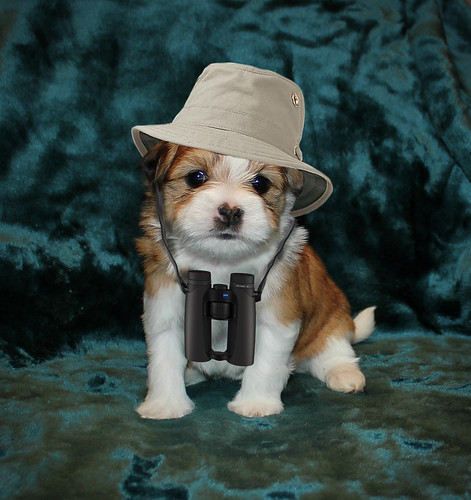 |
| My plucky sidekick Pip |
This weekend was the annual Hawk Ridge Birdathon—an event in which teams of birders compete to see the most species in a 24-hour period, each soliciting pledges in order to raise money for Hawk Ridge Bird Observatory. I was out of town, at a birding festival in Ohio, so couldn’t participate, but decided that this year instead I’ll do an informal "Sort-of-a-Big-Day" with my new puppy Pip.
Pip is too little to do a 2-am to 10-pm Big Day, much less a real midnight to midnight one, and since my heart attack, I get tired more quickly than I used to myself, so we’ll try for a more reasonable 5 or 6 am to as late as we can go on Thursday. The overall point is as a fund raiser, but I'm too timid to ask my friends, much less strangers, for pledges so I'm going to be donating $100 myself, but anyone who wanted to make a donation to Hawk Ridge in my and/or Pip's name (we're calling ourselves the Great Expectations team), I'd deeply appreciate it—here's the website for donations: http://www.hawkridge.org/support/donate/ (In the comments for vendor section, say you're making the donation for Pip and Laura's birdathon.)
So for the next couple of days I’m going to be plotting out our route. If we have more wonderful foggy weather, Park Point will be the perfect place to start out—warblers have been everywhere there this weekend (when I was gone, of course). One good strategy is to start out looking for warblers and other migrants at the point, then move to some of the shorebird spots and lakefront observation points in the Duluth area, and then work our way up to the bog, and then back to Duluth again. But if it is clear, as the current forecast calls for, fewer birds will be stopped from migrating, and Park Point won't be quite so ideal. In that case, Indian Point might be a better starting point.
As birds settle into their territories or at least spread out toward their migratory destinations, it’ll be important for us to cover a wide variety of nesting habitats. The trick is plotting out different routes for different weather conditions, and being flexible. My only constraint will be to stay within St. Louis County, but that’s hardly a sacrifice since this county is larger than four states.
The Cornell Lab of Ornithology’s eBird is a fantastic resource for knowing what birds have been seen where in real time, though in a big migration period, it can take longer for people to post what they’re seeing—they’re too much in the thick of watching it all. I have a wonderful app called Bird’sEye, produced in conjunction with the Cornell Lab, which tells me what birds have been seen in my area, often with specific directions to each place. All the information comes thanks to eBird. I have another app called BirdLog, which allows me to enter my data quickly and easily in the field so others can benefit from my sightings. In these ways, Cornell's eBird will be enormously helpful, but there are of course lots of places with sketchy phone connections in the wilder areas up here. Fortunately, I’ve been birding for 40 years now, since long before cell phones, and so I'm used to improvising without such aids. I’ll do my best to have some good plans in place before heading out, and will be flexible as far as coming up with alternatives when it seems like a good idea.
To do a Big Day, you need to focus ahead of time on other logistics besides route. There is little to no time for stopping for meals, so making sure the car is gassed up, and making sure there is plenty of food and water, a quick change of clothing, and extra shoes and boots in the car is important. Having Pip along will also require that I bring plenty of provisions for her. When I’m birding, I need both hands for using my binoculars and my camera, so can’t also be tugging at a leash. Fortunately, Pip quickly adapted to my system—I put her on a retractable leash, and hook the handle via a carabineer to my belt pouch. I keep the belt pouch with leash on every moment—my car works when I have my keys on my person, and keeping them in my belt pouch makes it impossible for me to leave my keys or wallet in the car if I stop suddenly for an interesting bird. It takes about 2 seconds for me to unzip her car carrier and hook her harness to the leash. And she's an agreeable little soul, so it takes only three seconds to unhook her and put her back in the carrier.I'll bring along an extra leash just in case, and my first aid kit will include emergency supplies for her, too.
If I were doing a real Big Day—going 2 am to 10 pm or longer—I’d be shooting for 150 species. As it is, I’ll be very happy to break into three digits at all. Pip’s lifelist is now over 150. I want her to end the month with 200, and hope our Big Day will bring her up to over 175. But I’m not all that goal oriented—as Forest Gump almost said, birdwatching is like a box of chocolates. You never know what you’re going to get, but it’s certain to be sweet.
(I would sure appreciate it if people donated to Hawk Ridge!)